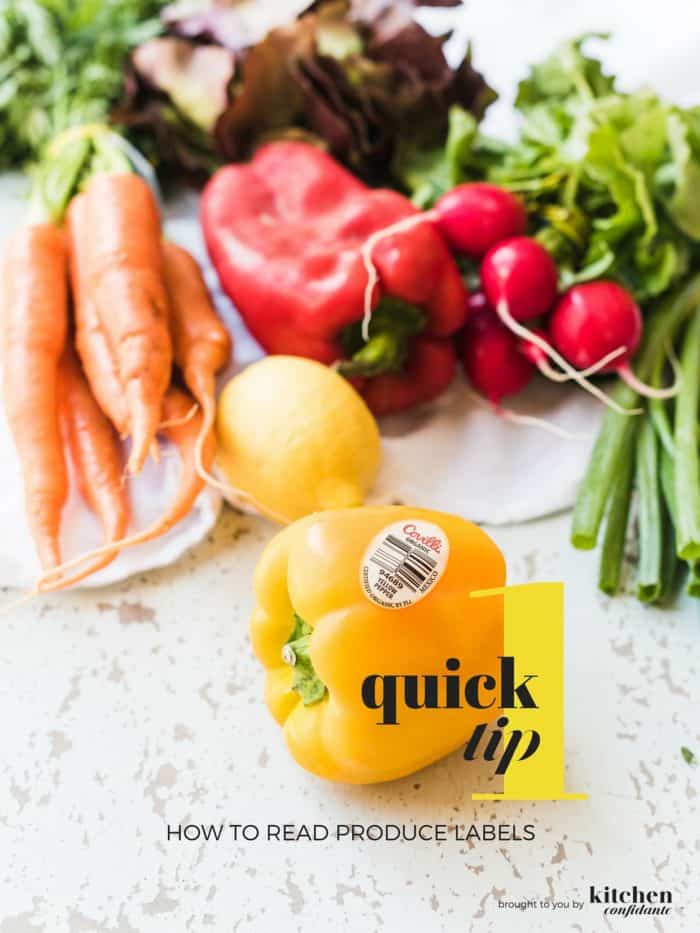
How to Read Produce Labels | One Quick Tip
How to read produce labels: Confused by produce labels (PLU codes)? Learn one quick tip to decode the code when shopping for fruits and vegetables!

Learn this quick tip for how to read produce labels when shopping for fruits and vegetables!
I’m so excited to announce a new series: One Quick Tip! I thought it would be fun (and hopefully helpful) to share quick tips that might come in handy when it comes to food, whether it’s around the kitchen or at grocery store. If you find it helpful, let me know – and if you have a tip to share, let me know! I would love to share your ideas in a future post so we can share it with everyone.
To kick off the series, here is one quick tip that will come in handy the next time you shop for fruits and vegetables: how to read produce labels.
HOW TO READ PRODUCE LABELS
Have you ever wondered what those pesky little stickers on our fruits and veggies mean? It’s not just a way to scan them at the check out counter. They can actually tell you so much more – where the fruit was grown, the producer, and more importantly, HOW it was grown. Here’s how to read produce labels when shopping for fresh fruits and vegetables:
Check out the fruit that’s on your counter or in your refrigerator — how many digits do you see? In general, fruits and vegetables have a 4 digit code, starting with a 3 or a 4. If you have an apple like I have here that has 4 digits, that means the apple was conventionally grown. It was likely treated with pesticides.
Now, sometimes that code is preceded by another number that will give you another clue into how it is produced.
If the PLU code is 5 digits and starts with the number 9, this indicates that the produce was grown organically. Many grocers will adequately label and separate their organic from non-organic fruits and vegetables, but once in a while, they do get mixed up! So when in doubt, look for the 9!
I hope you find this helpful! Let me know if you already knew this little trick, and if not, check it out with the produce you already have. And if you have any quick tips you would like to share, let me know – I’d be happy to spread the word!
MORE TIPS TO TRY
How to Pick the Perfect Fig
How to Pit Cherries Without a Cherry Pitter
How to Peel and Store Fresh Ginger
How to Cut a Squash Easily
How to Clean Stained Wine Glasses
SOME FAVORITE RECIPES FEATURING FRESH PRODUCE
Avocado Cucumber Salad
Avocado Corn Tomato Salad
Grilled Vegetable Pizza
Skillet Eggplant Lasagna
Roasted Tomato Caprese Skewers





















I just loved this, i had no idea at all. Thanks a lot
You learn something new everyday. Thanks for the great information. I never knew but I will certainly pay attention now.
Glad to help!
Woah! Thank you! Now, I know helpful tip when I go to a supermarket to buy food for my mother.
I didn’t know what these codes meant. We try to eat organic as much as possible so your tip is a great little help! Any tips for those with celiac disease or gluten intolerant and how to avoid gluten (maybe another how to read labels tip) would be fantastic for a future post.
I’m so glad this was helpful, Leigh-Ann. And I will definitely add tips for celiac disease/gluten intolerance in mind for future posts! I have a recipe coming up that is a gluten-free desert, so stay tuned!
OMG! I didn’t know about the meanings of the numbers in the codes till I read your post. Thank you for sharing this
Thanks for the tips! OMG! It’s so helpful! Keep it up!
Fantastic post I like it. Keep it up.
Thanks Liren :)
Oh my gosh!!! I had no idea!!! Thank you!
You’re so welcome! It’s nice to know and keep in your back pocket, isn’t it?